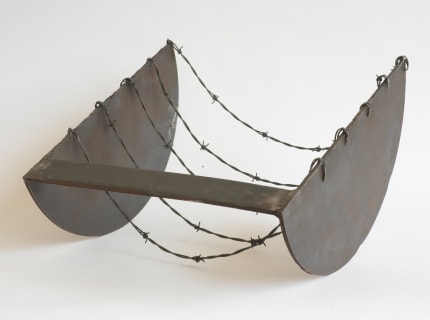The elegant stoop-like stairs indoors serve as a place for talks and performances and as a space for folks to just sit and chat. In the back corner is a marvelous terrazzo-clad staircase that rises up to the upper floors. Throughout the building is a light wood paneling detail that gives the building a sense of warmth.
Upon entering, take the elevator to the top. Up there, the sixth-floor rooftop terrace provides a clear, nearly 360-degree view of New York. (I wish the museum had also offered a nice view of large-scale outdoor sculptures, too, perhaps in the form of new commissions. No artworks are here, though that will hopefully change soon.) The Studio Museum has never felt closer to the surrounding city.
For decades, the opposite was true—the Studio Museum was almost invisible to the mainstream New York art world, whose scenes to the south never paid quite enough attention to what happened up here. After decades of putting in the hours, day in and day out, that is no longer the case. Despite its size, the Studio Museum has had a grand influence, not just in the New York art world but also nationally and internationally. It has achieved its tagline as “the nexus for artists of African descent locally, nationally, and internationally,” rewriting the canon and spurring many others to take up the work of spotlighting Black artists.
A visual timeline inside, in the form of an exhibition titled “To Be a Place,” attests to all that the museum has done since its founding in 1968. You get a sense of the constellation of Black artists it has supported—and been supported by—from Romare Bearden to Elizabeth Catlett, from Camille Billops to David Driskell, from Al Loving to Jack Whitten, from Melvin Edwards to William T. Williams, who laid the ground work for the Studio Museum’s famed artists-in-residence program, which has had 158 participants to date.
...
Read full article at artnews.com

